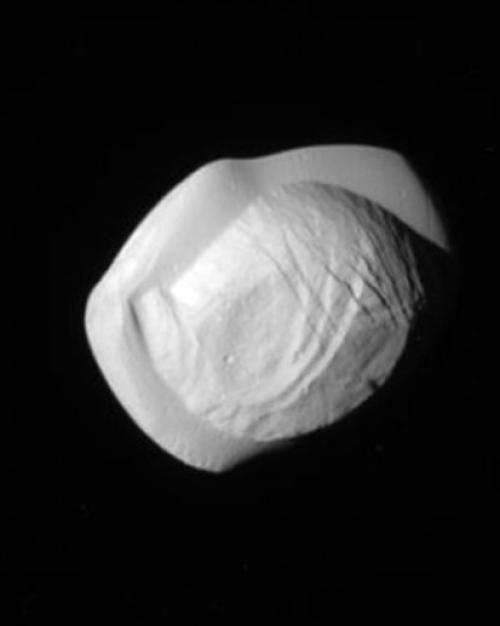Astronomy meets gastronomy: NASA’s Cassini spacecraft flew by and photographed a close-up of Saturn’s small moon Pan, never before seen in high resolution. Those images – as science hungered for joviality – revealed this moon looks like ravioli.
NASA and the Jet Propulsion Laboratory officially get credit for taking the picture, but Cornell astronomers – Mike Evans, research associate; Paul Helfenstein, senior research associate; Todd Ansty, research support specialist; Phil Nicholson, professor of astronomy; and Peter Thomas, visiting scientist – worked behind the scenes over the past year, planning and coordinating how to obtain the images.
Cassini’s March 7 flyby approached Pan at a distance of 15,268 miles and photographed more of its features and facets than scientists had imagined. “When I saw images for the first time, I said, ‘Holy smokes!’ I didn’t expect to see that kind of detail on the moon’s equatorial skirt,” Helfenstein said. “This is a game-changer on these ring satellites.”
On the web, the Twitterverse reacted in delight. Astronomy fans on Twitter called it “cosmic ravioli” or a “space walnut,” while others said Pan was a “wrinkled UFO.” Saturn’s moon even sparked a creative meme that features packaged Pan, with no artificial flavors or preservatives.
But the science behind the image started when the Cornell group negotiated with the other Cassini science and instrument teams to clarify timing of this observational opportunity.
The group also selected the camera’s color filters and suggested exposures. “Once our time slot was defined, we did much of the detailed image planning – which used computer oribital models and the locations of both Pan and the Cassini spacecraft in space in order to point the camera,” Helfenstein said.
Pan – named for the Greek god of shepherds and flocks – resides in the planet’s A-ring, loitering in the ring’s Encke Gap, a 200-mile-wide blank space, according to NASA. With a radius of about 8.8 miles, Pan sports a porous icy surface, pocked with craters, fractures and a wavy skirt around the equator. The moon gravitationally attracts the space flotsam, keeping the Encke Gap open.
Mark Showalter, M.S. ’82, Ph.D. ’85, a senior research scientist at the SETI Institute, discovered Pan in 1990 while examining thousands of low-resolution Voyager images taken in the early 1980s. He made the discovery when he worked for NASA.
Previously, NASA had an ambiguous notion of Pan’s shape. “We knew from lower-resolution images that Pan and Atlas (another tiny Saturn moon) have equatorial ridges, and we had vague ideas of their shapes,” said Thomas. “The sharpness of the boundary of the ridge … and some craters and grooves on it were a big surprise. The multiple fractures on the ‘core’ was also a big surprise.”
Nicholson isn’t shocked by Pan’s unusual shape. “There was a hint Pan and Atlas were shaped a bit like flying saucers. But the new Pan images show a much thinner, more sharply-defined ‘apron’ around the moon’s equator than any of us had imagined,” he said.
In January, NASA’s Cassini spacecraft imaged Saturn’s wave-making moon Daphnis, a sibling of Pan. Much like Pan, the moon keeps the Encke Gap clear. Due to the moon’s proximity to the edge of the ring particles, the moon’s gravity disturbs the particles – forming waves. On April 12, the Cassini spacecraft will image Atlas with coordinates supplied by the Cornell team.
Said Nicholson: “What I find most surprising is that Pan looks so different from Daphnis, which we imaged less than two months ago – as both are in similar environments – within the gaps in the outer A-ring.”
This story first appeared in the Cornell Chronicle.




